 资源简介
资源简介
/ 让教学更有效 高效备考 | 英语学科
Unit1-Unit10 词汇语法易错专项练习
一、词汇及语法选择题
The old man tried to ______ the mountains because they blocked his way.
A. move B. remove C. carry D. lift
The Monkey King can make 72 changes to his ______ and size.
A. shape B. color C. weight D. height
The new couple were ______ happy that they couldn’t stop smiling.
A. so B. such C. very D. too
Hansel and Gretel ______ white stones to find their way back.
A. dropped B. carried C. collected D. picked
You won’t understand the story ______ you read it carefully.
A. if B. unless C. when D. after
The emperor had to give silk to the brothers, but they ______ it for themselves.
A. kept B. sold C. gave D. returned
Qomolangma is higher than ______ mountain in Asia.
A. any B. any other C. other D. others
The Caspian Sea is the ______ salt lake in the world.
A. deep B. deeper C. deepest D. more deep
It’s hard ______ in thin air as you near the top of the mountain.
A. breathe B. to breathe C. breathing D. breathed
Pandas are endangered because humans ______ their forests.
A. cut down B. cut up C. cut off D. cut out
The baby panda is only 0.1kg ______ birth.
A. at B. in C. on D. by
The Yangtze River is one of the ______ rivers in the world.
A. longest B. shortest C. deepest D. highest
Sarah became a fan of country music ______ she heard a song on the radio.
A. until B. when C. ever since D. before
Country music ______ us of the good old days.
A. remembers B. reminds C. tells D. says
The singer has sold ______ 120 million records.
A. more B. over C. many D. much
I can’t wait ______ the new book about adventure.
A. read B. to read C. reading D. reads
Singapore is ______ to the equator, so the temperature is high.
A. far B. close C. near D. next
Three ______ of the population in Singapore are Chinese.
A. quarter B. quarters C. fourth D. four
You can find Chinese food ______ of China in Singapore.
A. inside B. outside C. in D. on
The boy has ______ the book for two weeks.
A. bought B. borrowed C. had D. lent
They decided to ______ old toys to a children’s home.
A. give up B. give away C. give out D. give in
She was sad to ______ with her favorite doll.
A. part B. take C. bring D. get
______ honest, I don't like this old book.
A. To be B. Being C. Be D. Been
The family is having a ______ sale to clear old things.
A. book B. yard C. clothes D. food
He no ______ lives here. He moved to another city.
A. longer B. long C. far D. further
While she ______ TV, her brother was doing homework.
A. watched B. was watching C. watches D. is watching
When I got home, my parents ______ dinner.
A. cook B. cooked C. were cooking D. are cooking
The rest of the milk ______ bad yesterday.
A. went B. go C. goes D. going
He has trouble ______ up early in the morning.
A. get B. to get C. getting D. got
She fell asleep ______ the light on.
A. with B. in C. on D. at
______ he is young, he knows a lot about history.
A. Although B. If C. When D. Because
The storm brought people ______ than before.
A. close B. closer C. closest D. the closest
Could you please ______ the window It’s cold.
A. close B. to close C. closing D. closed
______ you pass me the salt, please
A. Could B. Must C. Need D. Should
Neither my parents nor I ______ interested in games.
A. am B. is C. are D. be
The boy will call you as soon as he ______ home.
A. arrive B. arrives C. arrived D. will arrive
It’s important ______ good grades in exams.
A. get B. to get C. getting D. got
The man made it possible for her ______ to university.
A. go B. to go C. going D. went
The students keep ______ English every morning.
A. read B. to read C. reading D. reads
The woman was surprised ______ the news about pandas.
A. hear B. to hear C. hearing D. heard
The teacher told us ______ late for class.
A. not be B. not to be C. to not be D. not being
______ of the two girls is from China.
A. Neither B. Both C. All D. None
—______ you read Little Women yet —Yes, I have.
A. Do B. Did C. Have D. Has
Tina ______ Treasure Island and thinks it’s fantastic.
A. reads B. read C. has read D. is reading
How long ______ you been a fan of country music
A. How often B. How long C. How far D. How soon
The first people ______ the top were very brave.
A. reach B. to reach C. reaching D. reached
The song made Sarah ______ her family in China.
think about B. to think about
C. thinking about D. thought about
—I have never been to a science museum. —______.
Me too B. Me neither
C. So have I D. Neither do I
The singer ______ over 100 songs so far.
A. writes B. wrote C. has written D. is writing
______ the book is old, it’s still popular worldwide.
A. Because B. Although C. So D. But
二、词汇及语法填空题
The story reminds us never to give up ______ we face difficulties.
Yu Gong’s family decided to continue ______ (move) the mountains after his death.
The two brothers cheated the emperor by making ______ (magic) clothes.
Hansel had to change his plan because he couldn’t get ______ (many) white stones.
The Monkey King uses a ______ (magic) stick to fight bad people.
The children followed the bird’s song to a house made ______ bread and candy.
The ______ (high) of Qomolangma is 8,844.43 meters.
The Sahara is the largest ______ (desert) in the world.
China has a population of about 1.4 ______ (billion) people.
Climbers face difficulties ______ (such as/for example) freezing weather and storms.
Pandas are endangered because humans ______ (cut) down their forests.
Adult pandas spend 12 hours ______ (eat) about 10kg of bamboo daily.
The government is trying ______ (protect) the endangered pandas.
Sarah became a fan of country music ______ (ever since/when) she heard a song on the radio.
Country music ______ (remind) us of the good old days in the countryside.
The singer has sold ______ (over/more) 120 million records so far.
The book is so interesting that I can't ______ (put) it down.
Singapore is a small ______ (island) in Southeast Asia.
Three ______ (quarter) of the population in Singapore are Chinese.
The temperature in Singapore is almost the same ______ (all/ whole) year round.
I have ______ (already/yet) read the book three times.
The boy can't wait ______ (read) the new adventure story.
The man was named Friday because that’s the day Robinson ______ (meet) him.
Robinson Crusoe ______ (build) a house on the island alone.
The ______ (introduce) of the song made Sarah interested in country music.
They are having a ______ (yard) sale to sell old toys and books.
Amy wants to keep her old toys because they ______ (bring) back sweet memories.
He has ______ (have) the bike for three years since his 10th birthday.
The family decided to ______ (give) away old clothes to the poor.
She was sad to ______ (part) with her favorite doll.
______ (To be) honest, I don’t like this kind of music.
The old man no ______ (long) lives here; he moved away.
While Linda ______ (sleep), Jenny was helping Mary with homework.
When I got home, my parents ______ (cook) dinner in the kitchen.
The rest of the students ______ (be) cleaning the classroom yesterday.
He has trouble ______ (get) up early on weekends.
She fell asleep ______ (with) the light on last night.
______ (Although) he is young, he knows a lot about history.
The storm brought people ______ (close) than before.
Could you please ______ (close) the window It’s windy outside.
______ (Could) you pass me the dictionary, please
Neither my sister nor I ______ (be) interested in playing chess.
The boy will call you as soon as he ______ (arrive) at the station.
It’s important ______ (learn) English well for international communication.
The teacher made it possible for us ______ (understand) the difficult passage.
The students keep ______ (read) English every morning.
The woman was surprised ______ (hear) the news about the accident.
The teacher told the students ______ (not be) late for the exam.
______ (Neither) of the two books is interesting; I don’t like them.
—______ (Have) you ever been to the Great Wall —Yes, twice.
三、语法段落填空题(两篇)
第一篇
Once upon a time, there was an old man ______1 (call) Yu Gong. He lived near two big mountains, which ______2 (take) a long time to cross. So he decided ______ 3(move) them. His family ______4 (help) him carry earth to the sea. A man said he was too old, but Yu Gong believed his family could ______5 (continue) after his death. The story tells us that anything is possible if we don’t ______ 6(give) up. Another story is about the Monkey King, who can make 72 changes to his ______ 7(shape) and size. He uses a ______ 8(magic) stick to fight bad people, but he can’t turn into a man unless he ______9 (hide) his tail. These stories ______10 (teach) us to be brave and never give up.
第二篇
Qomolangma, the ______ 11(high) mountain in the world, is 8,844.43 meters tall. Climbing it is difficult because of ______ 12(freeze) weather and heavy storms. The first people ______13 (reach) the top in 1953 were Tenzing and Edmund. Pandas are ______14 (endanger) animals. At birth, a baby panda is only 0.1kg. Adult pandas spend over 12 hours ______15 (eat) bamboo. The Chinese government is trying ______16 (save) them by creating more nature parks. In Singapore, a small ______17 (island) in Asia, three ______18 (quarter) of the population are Chinese. The temperature is almost the same ______19 (all) year, so you can visit ______ 20(whenever) you like.
答案与解析
一、词汇语法选择题
A
解析:move the mountains 表示 “移山”,是固定搭配,remove 侧重 “移除”,carry “搬运”,lift “举起”,均不符合语境。
A
解析:shape 与 size 并列表示 “形状和大小”,其他选项 color(颜色)、weight(重量)、height(高度)不符合故事内容。
A
解析:so + 形容词 + that... 表示 “如此…… 以至于”,happy 是形容词,用 so;such 后接名词,排除 B。
A
解析:drop stones 表示 “沿途扔石头”,carry “携带”、collect “收集”、pick “捡起” 均不符合 Hansel 标记路线的行为。
B
解析:unless=if not,表示 “除非”,符合 “除非仔细读,否则不懂故事” 的逻辑,if “如果”、when “当”、after“在…… 之后” 均不符。
A
解析:keep sth. for oneself 表示 “把某物留给自己”,符合两兄弟欺骗皇帝的情节,sell “卖”、give “给”、return “归还” 均不符。
B
解析:any other + 单数名词表示 “其他任何一个”,用于同一范围内比较;any + 单数名词用于不同范围,亚洲范围内比较用 any other。
C
解析:the + 最高级表示 “最……”,deep 的最高级是 deepest,无需加 more,排除 D。
B
解析:It's hard to do sth. 是固定句型,用不定式 to breathe,故选 B。
A
解析:cut down forests 表示 “砍伐森林”,cut up “切碎”、cut off “切断”、cut out “删除” 均不符合语境。
A
解析:at birth 表示 “出生时”,是固定搭配,其他介词不与 birth 构成此意。
A
解析:长江是世界上 “最长的” 河流之一,用 longest,shortest “最短”、deepest “最深”、highest “最高” 均不符。
C
解析:ever since + 过去时间点,用于现在完成时;when 引导过去时从句,此处主句为现在完成时,用 ever since。
B
解析:remind sb. of sth. 表示 “使某人想起”,是固定搭配,其他动词无此用法。
B
解析:over=more than 表示 “超过”,后接具体数字,more 需与 than 连用,排除 A。
B
解析:can't wait to do sth. 表示 “迫不及待做某事”,用不定式 to read,故选 B。
B
解析:be close to 表示 “靠近”,后接地点;near 是介词,直接接宾语,无需 be 动词,排除 C。
B
解析:three quarters 表示 “四分之三”,quarter 用复数,fourth “第四” 不符合分数表达。
B
解析:outside of China 表示 “在中国之外”,新加坡的中餐属于 “中国之外的中餐”,inside “内部” 不符。
C
解析:buy、borrow、lend 是短暂性动词,不能与 for two weeks 连用;have 是延续性动词,故选 C。
B
解析:give away sth. to... 表示 “把某物捐赠给……”,give up
21. B.
解析:give up 表示 “放弃”;give away 意为 “赠送;捐赠”,符合 “把旧玩具捐给儿童之家” 的语境;give out 表示 “分发;用尽”;give in 意为 “屈服”。
A.
解析:part with sth. 为固定搭配,意为 “与…… 分开;舍弃”,符合 “难过地舍弃最爱的玩偶” 的语义;其他选项(take、bring、get)均不与 “with” 构成此含义的搭配。
A.
解析:To be honest 是固定短语,意为 “说实话”,用于句首表坦白,属于不定式作状语的用法;其他选项(Being、Be、Been)均不构成该固定搭配。
B.
解析:yard sale 是固定短语,指 “庭院旧货出售”,符合 “清理旧物” 的语境;其他选项(book、clothes、food)虽可与 “sale” 搭配,但与 “clear old things” 的场景不符。
25. A.
解析:no longer 为固定搭配,意为 “不再”,修饰动词 “lives”,表示 “不再住在这里”;no long 搭配错误,far/further 不与 “no” 构成 “不再” 的含义。
26. B.
解析:由 “while” 引导的时间状语从句中,主从句动作同时发生且持续,用过去进行时(was/were + doing);主语 “she” 为第三人称单数,故用 “was watching”。
C.
解析:
“when” 引导的时间状语从句用一般过去时(got home),主句表示 “当时正在做某事”,用过去进行时;主语 “my parents” 为复数,故用 “were cooking”。
28. A.
解析:“yesterday” 表明时态为一般过去时,“go bad”(变坏)的过去式为 “went”;其他选项(go、goes、going)时态不符。
29. C.
解析:have trouble (in) doing sth. 为固定结构,意为 “做某事有困难”,介词 “in” 可省略,故用动名词 “getting”。
30. A.
解析:with + 宾语 + 宾补(形容词 / 介词短语等) 构成独立主格结构,表示伴随状态;“with the light on” 意为 “灯开着”,符合 “她开着灯睡着了” 的语境。
31. A.
解析:前后句为让步关系,“尽管他年轻,但对历史了解很多”,用Although引导让步状语从句;If(如果)表条件,When(当…… 时)表时间,Because(因为)表原因,均不符合逻辑。
32. B.
解析:由 “than before” 可知用比较级,“close” 的比较级为 “closer”,表示 “暴风雨让人们比以前更亲近”。
33. A.
解析:Could you please + 动词原形 为固定句型,意为 “请你做…… 好吗?”,故用 “close”。
A.
解析:Could you please... 用于礼貌请求,意为 “你能…… 吗?”,符合 “请递盐” 的语境;Must(必须)、Need(需要)、Should(应该)均不表请求。
35. A.
解析:Neither...nor... 遵循 “就近原则”,谓语动词与靠近的主语 “I” 一致,故用 “am”。
36. B.
解析:as soon as 引导的时间状语从句中,主句用一般将来时(will call),从句用一般现在时表将来;主语 “he” 为第三人称单数,故用 “arrives”。
37. B.
解析:It’s important to do sth. 为固定句型,意为 “做某事很重要”,用不定式 “to get” 作真正主语。
38. B.
解析:make it possible for sb. to do sth. 为固定结构,意为 “使某人做某事成为可能”,用不定式 “to go”。
39. C.
解析:keep doing sth. 为固定搭配,意为 “持续做某事”,故用动名词 “reading”。
40. B.
解析:be surprised to do sth. 为固定结构,意为 “做某事感到惊讶”,用不定式 “to hear”。
41. B.
解析:tell sb. not to do sth. 为固定搭配,意为 “告诉某人不要做某事”,否定式在不定式前加 “not”,即 “not to be”。
42. A.
解析:“the two girls” 表明范围为 “两者”,Neither of... 表示 “两者都不”,后接单数谓语;Both of... (两者都)接复数谓语,与句中 “is” 不符;All/None 用于三者及以上。
43. C.
解析:由 “yet” 及答语 “Yes, I have.” 可知,问句用现在完成时(have/has + 过去分词),主语 “you” 对应 “Have”。
44. C.
解析:“thinks it’s fantastic”(认为很棒)表明 “已读过《金银岛》”,用现在完成时(has read),表示过去动作对现在的影响;reads/read/is reading 均不体现 “已完成” 的含义。
45. B.
解析:由 “have you been...” 及 “how long” 可知,问句询问 “成为乡村音乐粉丝多久了”,用How long(多久)提问时间段;How often(多久一次)问频率,How far(多远)问距离,How soon(多久以后)问将来时间。
46. B.
解析:the first people to do sth. 为固定结构,不定式 “to reach” 作后置定语,修饰 “the first people”,表示 “第一批到达山顶的人”。
47. A.
解析:make sb. do sth. 为固定搭配,意为 “使某人做某事”,用动词原形 “think about”。
48. B.
解析:前句 “have never been” 为现在完成时的否定,答语表示 “我也没去过”,用Me neither(= Neither have I);Me too(我也是)用于肯定句,So have I 语序错误,Neither do I 时态不符(助动词应为 “have”)。
49. C.
解析:“so far”(到目前为止)为现在完成时标志,结构为 “has/have + 过去分词”,主语 “the singer” 为单数,故用 “has written”。
50. B.
解析:前后句为让步关系,“尽管这本书很旧,但在世界范围内仍很受欢迎”,用Although引导让步状语从句;Because(因为)表原因,So(所以)表结果,But(但是)不用于句首引导从句。
词汇语法填空题
1. when
解析:句意为 “故事提醒我们,当面对困难时永不放弃”。when 引导时间状语从句,符合 “面对困难时” 的语境。
2. moving
解析:continue doing sth. 表示 “继续做某事”(持续同一件事),此处指愚公死后家人继续移山,用动名词形式。
3. magic
解析:形容词 magic 修饰名词 clothes,意为 “魔法的衣服”,此处无需变形。
4. more
解析:couldn’t get more 表示 “无法得到更多”,more 在此为形容词比较级,指 “更多的” 白石子。
5. magic
解析:形容词 magic 修饰名词 stick,“magic stick” 表示 “金箍棒”,固定搭配。
6. of
解析:be made of 表示 “由…… 制成”(可见原材料),房子由面包和糖果制成,用介词 of。
7. height
解析:定冠词 the 后接名词,high 的名词形式为 height,“the height of” 表示 “…… 的高度”。
8. desert
解析:Sahara(撒哈拉)是单数沙漠,用名词单数形式 desert。
9. billion
解析:billion 前有具体数字 1.4 时,用单数形式,“1.4 billion” 表示 “14 亿”。
10. such as
解析:such as 后接多个例子(如 freezing weather 和 storms),for example 后通常接单个例子,用逗号隔开。
11. cut
解析:熊猫濒危是因为人类砍伐森林,用一般现在时表示客观事实,cut 的原形与主语 humans 一致。
12. eating
解析:spend time doing sth. 为固定搭配,“花费时间做某事”,用动名词 eating。
13. to protect
解析:try to do sth. 表示 “努力做某事”,政府努力保护熊猫,用不定式 to protect。
14. ever since
解析:ever since + 过去时间点,主句用现在完成时(became 为一般过去时,此处强调从过去某时起的持续状态);when 引导时间状语从句,时态需一致,此处更符合 “自从听到歌后成为粉丝” 的语境。
15. reminds
解析:country music 为不可数名词,作主语时谓语动词用第三人称单数形式 reminds。
16. over
解析:over=more than,表示 “超过”,后接具体数字时 over 更常用,“over 1.2 亿张唱片”。
17. put
解析:can’t put sth. down 为固定短语,意为 “对某物爱不释手”,情态动词 can’t 后接动词原形。
18. island
解析:Singapore 是单数岛屿,用名词单数 island。
19. quarters
解析:three 后接可数名词复数,quarter 的复数为 quarters,“three quarters” 表示 “四分之三”。
20. all
解析:all year round 为固定搭配,意为 “一整年”;whole 前需加 the,如 “the whole year”。
21. already
解析:already 用于肯定句,表示 “已经”;yet 用于否定句或疑问句,此处为肯定句,用 already。
22. to read
解析:can’t wait to do sth. 为固定搭配,“迫不及待做某事”,用不定式 to read。
23. met
解析:Robinson 遇见 Friday 是过去的事,用一般过去时 meet 的过去式 met。
24. built
解析:鲁滨逊在岛上建房是过去的行为,用一般过去时 build 的过去式 built。
25. introduction
解析:定冠词 the 后接名词,introduce 的名词形式为 introduction,“歌曲的介绍”。
26. yard
解析:yard sale 为固定短语,意为 “庭院旧货出售”,用名词作定语,用单数形式。
27. bring
解析:玩具带来甜蜜回忆是现在的客观情况,用一般现在时,主语 they 后接动词原形 bring。
28. had
解析:“for three years” 为现在完成时标志,结构为 has/have + 过去分词,have 的过去分词为 had。
29. give
解析:decide to do sth. 为固定搭配,“决定做某事”,用动词原形 give。
30. part
解析:be sad to do sth. 表示 “做某事感到难过”,part with sth. 为固定短语,“与某物分开”,用动词原形。
31. To be
解析:to be honest 为固定短语,意为 “说实话”,位于句首首字母大写。
32. longer
解析:no longer 为固定短语,意为 “不再”,修饰动词 lives,表示老人不再住这里。
33. was sleeping
解析:while 引导的时间状语从句中,两个动作同时进行,用过去进行时 was sleeping,与主句的过去进行时 was helping 呼应。
34. were cooking
解析:when 引导的时间状语从句用一般过去时,主句表示 “当时正在做饭”,用过去进行时 were cooking(parents 为复数)。
35. were
解析:the rest of + 复数名词 students 作主语,谓语动词用复数;yesterday 为过去时间,用 were。
36. getting
解析:have trouble doing sth. 为固定搭配,“做某事有困难”,用动名词 getting。
37. with
解析:with the light on 为 “with + 宾语 + 宾补” 结构,表示 “灯开着”,作伴随状语。
38. Although
解析:although 引导让步状语从句,意为 “尽管”,句首首字母大写,符合 “尽管年轻却懂很多历史” 的逻辑。
39. closer
解析:than 为比较级标志,close 的比较级为 closer,“风暴让人们比以前更亲近”。
40. close
解析:Could you please do sth. 为委婉请求,后接动词原形 close,“请关窗”。
41. Could
解析:Could you... 表示委婉请求,句首首字母大写,“请递给我字典”。
42. am
解析:neither...nor... 遵循 “就近原则”,靠近谓语的主语是 I,用 am,“我和姐姐都不对下棋感兴趣”。
43. arrives
解析:as soon as 引导的时间状语从句用一般现在时表将来,主语 he 为第三人称单数,用 arrives。
44. to learn
解析:It’s important to do sth. 为固定句型,“做某事很重要”,用不定式 to learn。
45. to understand
解析:make it possible for sb. to do sth. 为固定结构,“使某人可能做某事”,用不定式 to understand。
46. reading
解析:keep doing sth. 表示 “持续做某事”,学生每天坚持读英语,用动名词 reading。
47. to hear
解析:be surprised to do sth. 为固定搭配,“做某事感到惊讶”,用不定式 to hear。
48. not to be
解析:tell sb. not to do sth. 为固定结构,“告诉某人不要做某事”,用 not to be。
49. Neither
解析:neither of + 复数名词表示 “两者都不”,谓语动词用单数 is,符合 “两本书都没趣” 的语境。
50. Have
解析:ever been to 为现在完成时标志,主语 you 对应助动词 have,句首首字母大写。
三、语法段落填空题
第一篇语法填空
1. called
解析:过去分词作后置定语,修饰 “an old man”,表示 “被叫做愚公的老人”,相当于定语从句 “who was called Yu Gong”。
2. took
解析:时态为一般过去时,描述故事背景。“which” 指代 “two big mountains”,穿越两座山 “花费很长时间” 是过去的事实,故用 “take” 的过去式 “took”。
3. to move
解析:固定搭配 “decide to do sth.”,表示 “决定做某事”,故填不定式 “to move”。
4. helped
解析:时态为一般过去时,故事中家人 “帮助他” 是过去发生的动作,用 “help” 的过去式 “helped”。
5. continue
解析:情态动词 “could” 后接动词原形,“continue” 表示 “继续”,符合语境 “愚公相信家人在他死后能继续移山”。
6. give
解析:否定助动词 “don’t” 后接动词原形,“give up” 为固定短语,意为 “放弃”。
7. shape
解析:“shape” 与 “size” 并列,均为名词,指 “形状和大小”。“72 changes” 表示 “七十二变”,改变的是外形和尺寸,故用单数形式。
8. magic
解析:形容词修饰名词 “stick”,“magic” 意为 “有魔力的”,“magic stick” 指 “金箍棒”。
9. hides
解析:时态为一般现在时,条件状语从句 “unless” 中,主语 “he” 是第三人称单数,故动词 “hide” 用第三人称单数形式 “hides”,表示 “除非他隐藏尾巴,否则不能变成人”。
10. teach
解析:时态为一般现在时,主语 “These stories” 是复数,动词用原形 “teach”,描述故事传达的道理。
第二篇语法填空
11. highest
解析:形容词最高级,“the highest mountain” 表示 “世界上最高的山”,与 “in the world” 范围对应。
12. freezing
解析:形容词修饰名词 “weather”,“freezing” 意为 “极冷的”,“freezing weather” 指 “严寒的天气”,区别于 “frozen”(冷冻的)。
13. to reach
解析:不定式作后置定语,修饰 “the first people”,表示 “1953 年第一批到达山顶的人”,“the first + n. + to do” 为固定结构。
14. endangered
解析:形容词修饰名词 “animals”,“endangered” 意为 “濒危的”,“endangered animals” 指 “濒危动物”,区别于 “endangering”(危及的)。
15. eating
解析:固定搭配 “spend time (in) doing sth.”,表示 “花费时间做某事”,故填动名词 “eating”,“spend 12 hours eating bamboo” 意为 “花 12 小时吃竹子”。
16. to save
解析:固定搭配 “try to do sth.”,表示 “努力做某事”,政府 “试图拯救它们”,用不定式 “to save”。
17. island
解析:名词单数,“a small island” 表示 “一个小岛”,新加坡是单个岛屿,用单数形式。
18. quarters
解析:“three quarters” 表示 “四分之三”,固定表达,“quarter” 为可数名词,复数加 “s”。
19. all
解析:“all year round” 为固定短语,意为 “全年”,“all” 强调整个时间段,而 “whole” 通常接 “the whole year”。
20. whenever
解析:连接副词引导时间状语从句,“whenever” 意为 “无论何时”,表示 “你可以随时去参观”,符合 “全年气温相同” 的语境。
展开更多......
收起↑
 资源预览
资源预览
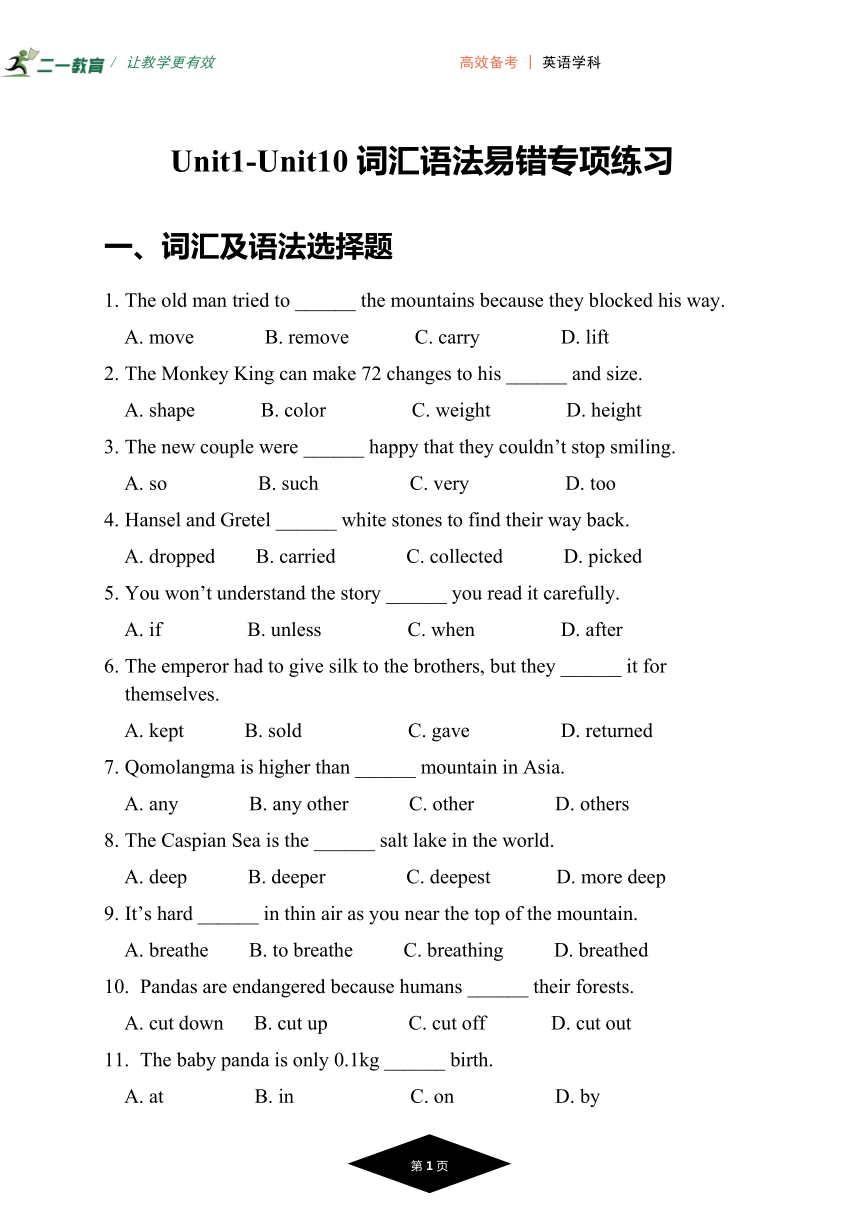
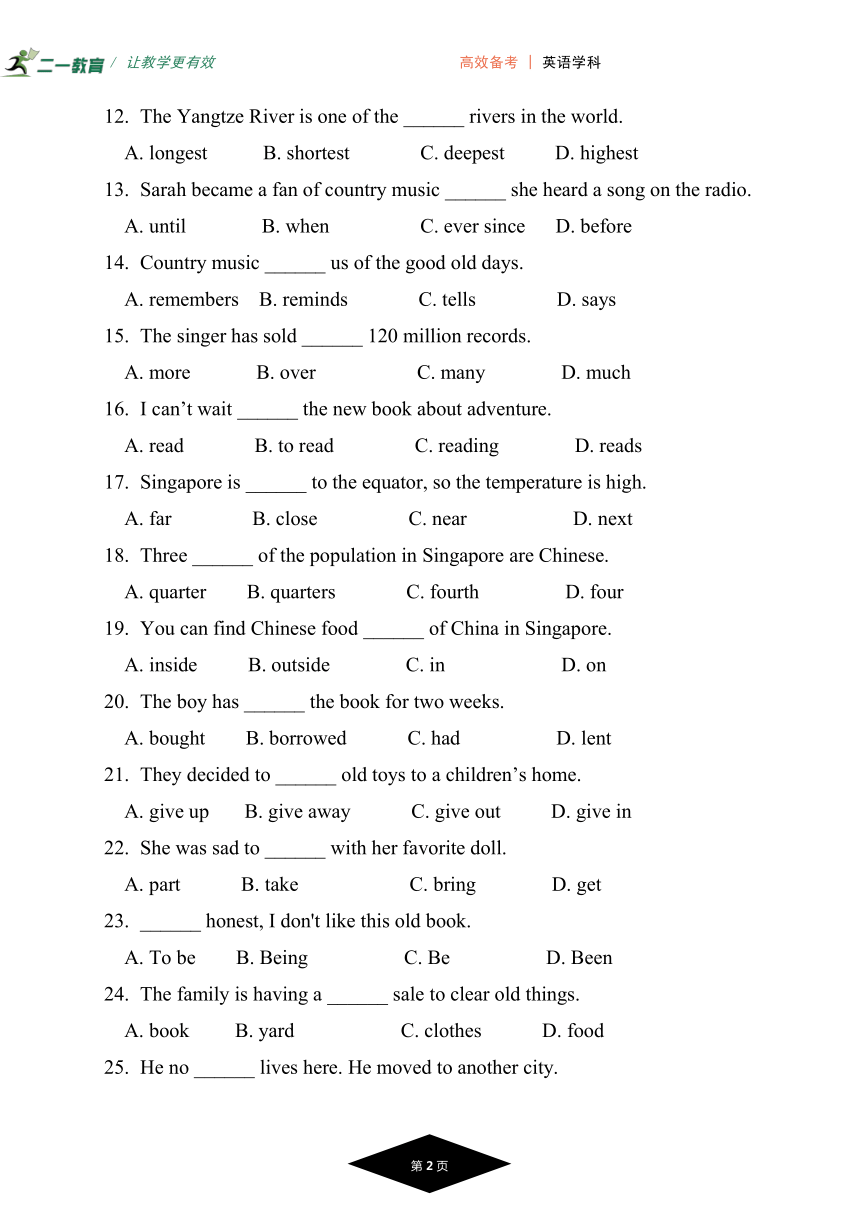
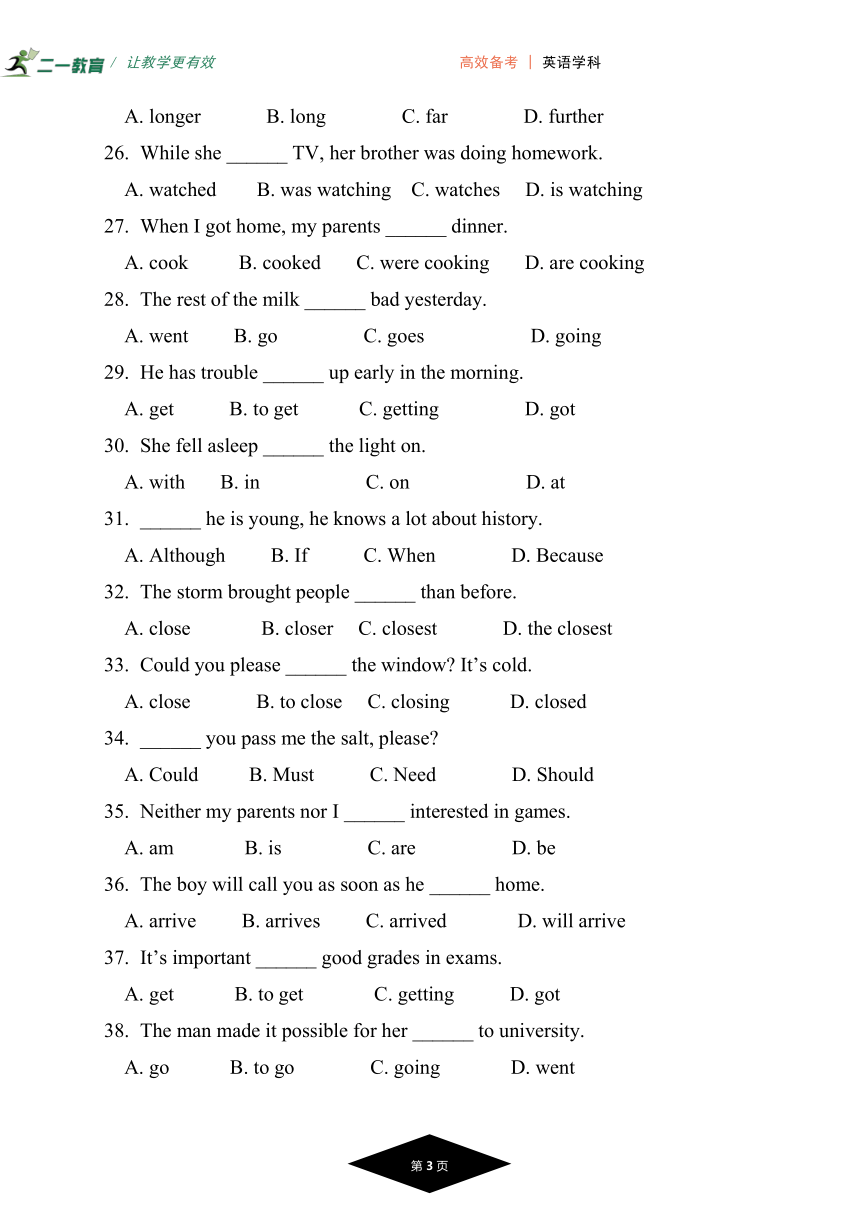
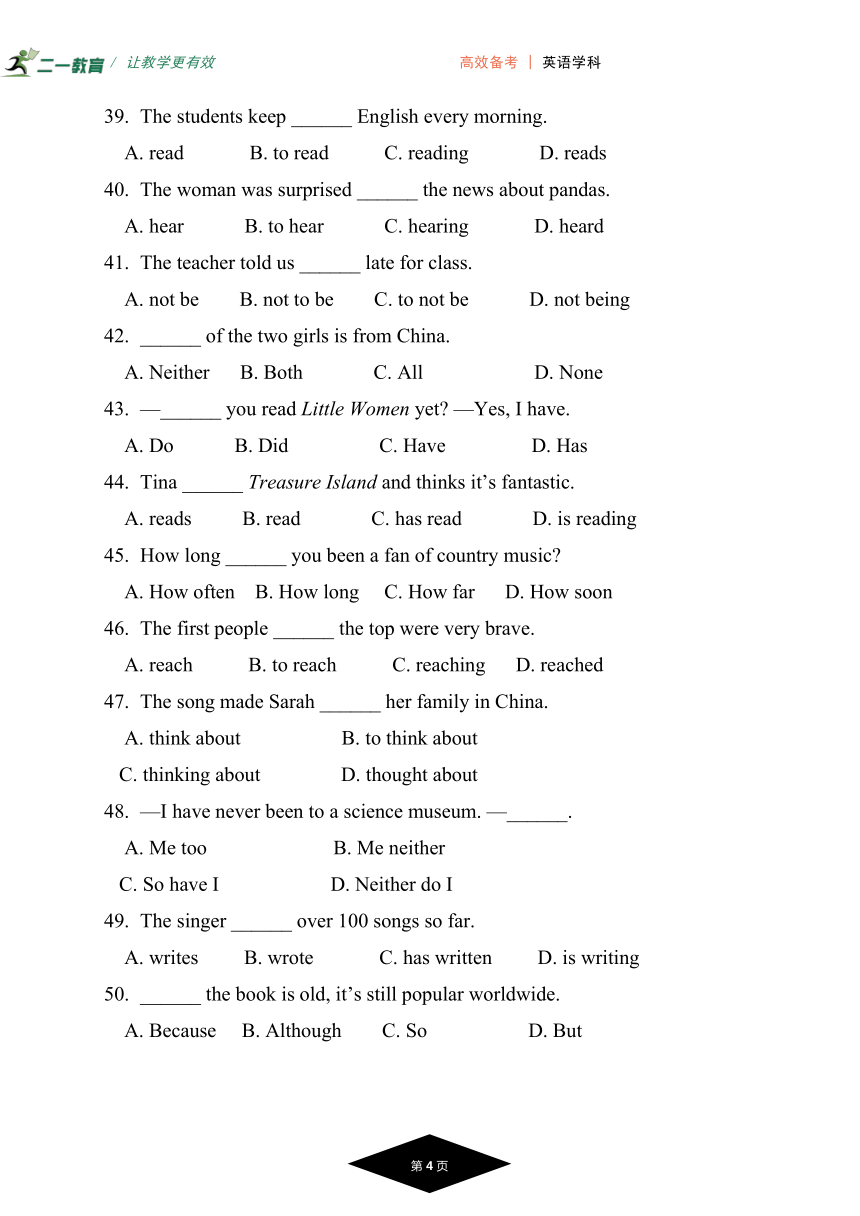
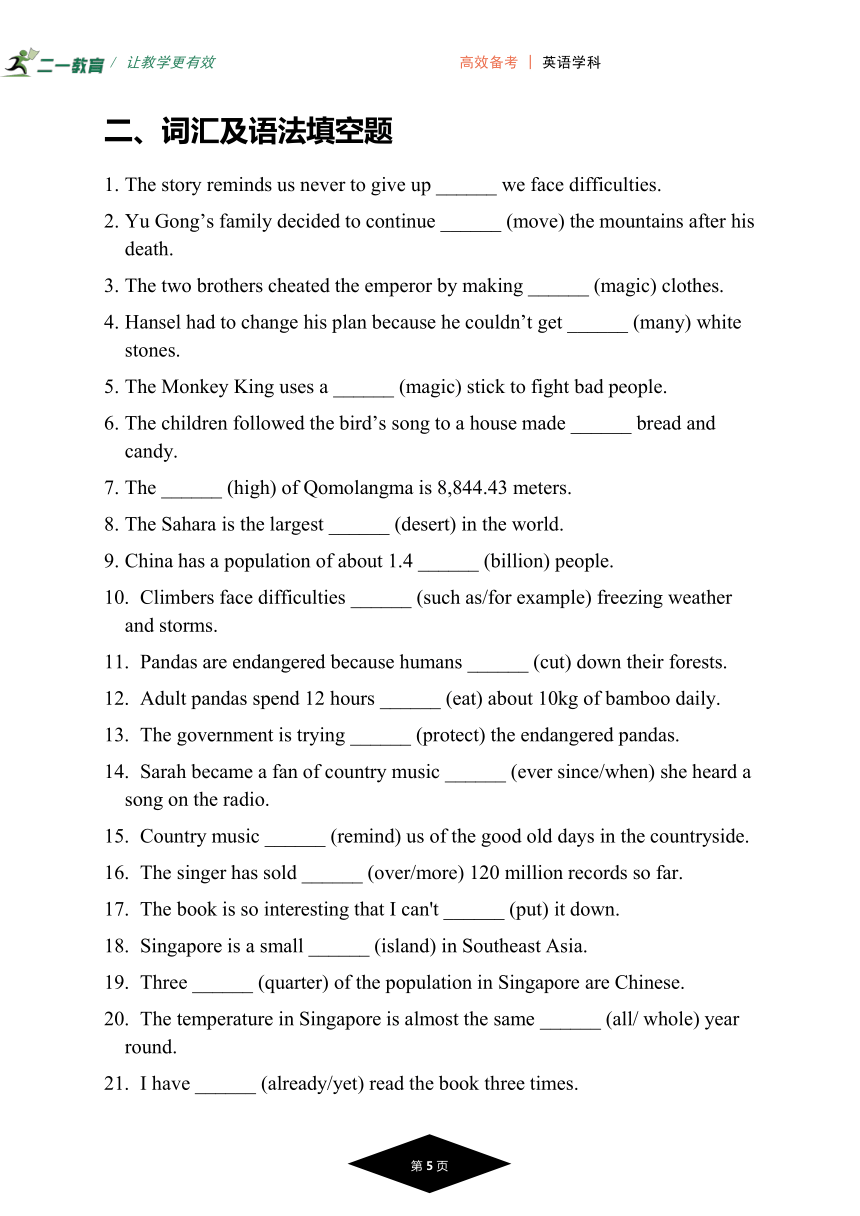
 资源预览
资源预览




